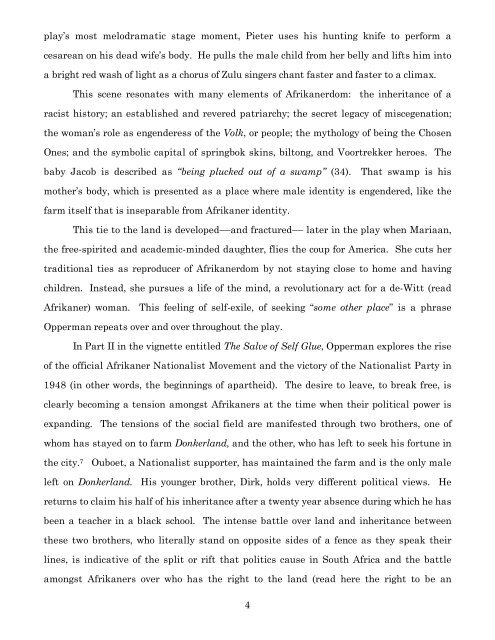De/Re-Constructing Borders - University of Minnesota
De/Re-Constructing Borders - University of Minnesota
De/Re-Constructing Borders - University of Minnesota
Create successful ePaper yourself
Turn your PDF publications into a flip-book with our unique Google optimized e-Paper software.
play’s most melodramatic stage moment, Pieter uses his hunting knife to perform a<br />
cesarean on his dead wife’s body. He pulls the male child from her belly and lifts him into<br />
a bright red wash <strong>of</strong> light as a chorus <strong>of</strong> Zulu singers chant faster and faster to a climax.<br />
This scene resonates with many elements <strong>of</strong> Afrikanerdom: the inheritance <strong>of</strong> a<br />
racist history; an established and revered patriarchy; the secret legacy <strong>of</strong> miscegenation;<br />
the woman’s role as engenderess <strong>of</strong> the Volk, or people; the mythology <strong>of</strong> being the Chosen<br />
Ones; and the symbolic capital <strong>of</strong> springbok skins, biltong, and Voortrekker heroes. The<br />
baby Jacob is described as “being plucked out <strong>of</strong> a swamp” (34). That swamp is his<br />
mother’s body, which is presented as a place where male identity is engendered, like the<br />
farm itself that is inseparable from Afrikaner identity.<br />
This tie to the land is developed––and fractured–– later in the play when Mariaan,<br />
the free-spirited and academic-minded daughter, flies the coup for America. She cuts her<br />
traditional ties as reproducer <strong>of</strong> Afrikanerdom by not staying close to home and having<br />
children. Instead, she pursues a life <strong>of</strong> the mind, a revolutionary act for a de-Witt (read<br />
Afrikaner) woman. This feeling <strong>of</strong> self-exile, <strong>of</strong> seeking “some other place” is a phrase<br />
Opperman repeats over and over throughout the play.<br />
In Part II in the vignette entitled The Salve <strong>of</strong> Self Glue, Opperman explores the rise<br />
<strong>of</strong> the <strong>of</strong>ficial Afrikaner Nationalist Movement and the victory <strong>of</strong> the Nationalist Party in<br />
1948 (in other words, the beginnings <strong>of</strong> apartheid). The desire to leave, to break free, is<br />
clearly becoming a tension amongst Afrikaners at the time when their political power is<br />
expanding. The tensions <strong>of</strong> the social field are manifested through two brothers, one <strong>of</strong><br />
whom has stayed on to farm Donkerland, and the other, who has left to seek his fortune in<br />
the city. 7 Ouboet, a Nationalist supporter, has maintained the farm and is the only male<br />
left on Donkerland. His younger brother, Dirk, holds very different political views. He<br />
returns to claim his half <strong>of</strong> his inheritance after a twenty year absence during which he has<br />
been a teacher in a black school. The intense battle over land and inheritance between<br />
these two brothers, who literally stand on opposite sides <strong>of</strong> a fence as they speak their<br />
lines, is indicative <strong>of</strong> the split or rift that politics cause in South Africa and the battle<br />
amongst Afrikaners over who has the right to the land (read here the right to be an<br />
4
















